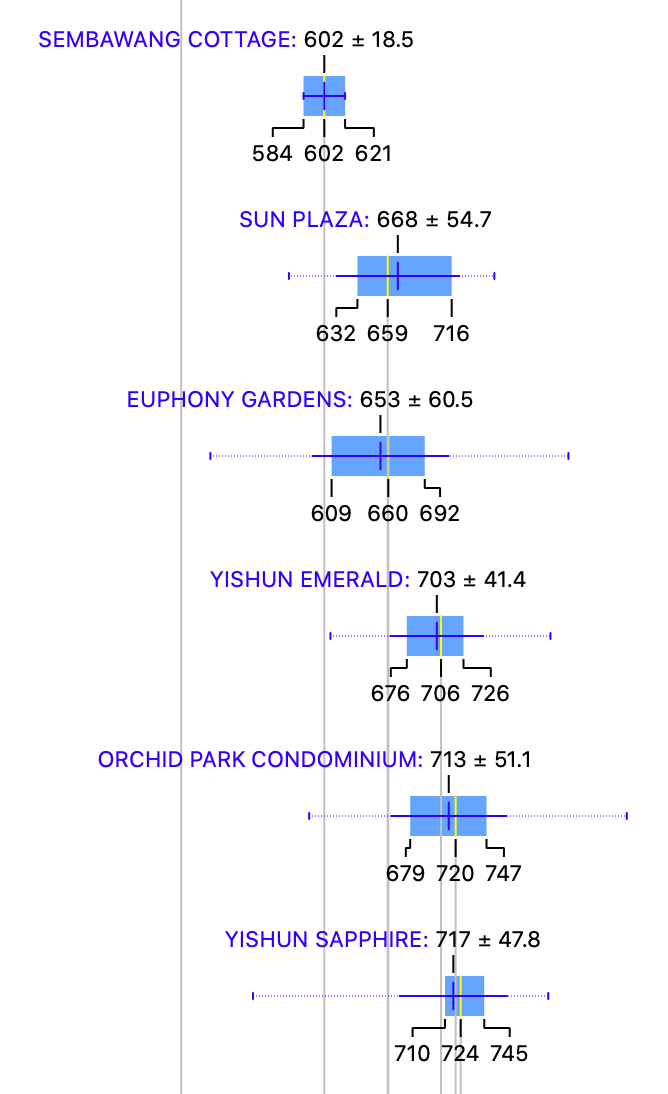Buying a private property in District 27
- datascienceinvestor

- Feb 12, 2020
- 6 min read
Updated: May 17, 2020

(Photo credit: Wikipedia)
Date of Analysis: 4 February 2020
Period of data: Feb 2017 to Jan 2020
Number of transactions analyzed: 1332
(transaction data extracted from URA website)
District 27 is one of the districts within the OCR (Outside of Central Region) of Singapore. It comprises of few neighbourhoods such as Sembawang, Yishun and Admiralty. Some of the private properties in this region are Canberra Residences, The Estuary and Orchid Park Condominium etc. Some of the recent new projects in this district are The Wisteria, North Park Residences and Sea Kandis Residences.
How do the private properties in D27 generally fare? Using box plots, here are the details for each of the properties in D27.
More box plots of other condominiums in this district (together with all the other districts) could be unlocked when you become a patron (https://www.patreon.com/datascienceinvestor)
To help you better understand the data, I will use Kandis Residence as an example here. From the diagram, you can see that

Average price- $1272 psf
Median price- $1275 psf
Price at 25th percentile- $1231 psf
Price at 75th percentile- $1319 psf
Box plot is generally a good way to present the data. In this case, you can easily see the average price, median price, price at 25th percentile and price at 75th percentile from the plots. You could also easily tell at one glance how wide the spread of prices are for any of the condominium projects.
The metric used here is $psf as it is a common indicator to reflect property prices.
The most expensive condominium in D27 is North Park Residences with an average price of $1272 psf while the most affordable condominium in D27 is Sembawang Cottage with an average price of $602 psf. North Park Residences is a 99 year leasehold property and part of a mixed development comprising of Northpoint City. Not only does it have a full shopping center right at its doorstep, it also has Yishun MRT right at its doorstep too. It's no wonder that it is the most expensive condominium in D27, even surpassing the other freehold properties in D27 (though it's also worthwhile to note that the freehold properties in D27 have all TOP quite some years ago)
Let's take a look at the various scatter plots to have a better insight of how the property prices perform across 1332 transactions in the past 3 years.

First, a scatter plot of the $psf against date.
In scatter plot, we could derive r coefficient, which is used to explain the strength of the linear relationship between 2 variables. Since we are using $psf and date as the variables, r coefficient allows us to better understand how the $psf changes with time. To some extent, if the r coefficient is high, we could roughly assume that the $psf increases positively with time.
The r coefficient (or much simply/loosely put, the gradient for the line of best fit) in the scatter plot above is a disappointing -0.17. This means that the $psf in D27 is actually decreasing over the past 3 years. It now joins my new group of districts which have a negative $psf trend for the past 3 years, comprising of D25, D22 and D16. The main difference though is that most districts suffer a drop in $psf primarily because there are no new private properties projects in the district. D27 is different though. It has quite a number of new properties projects in the district, yet its $psf trend is negative.

Based on the graph above, you could also better understand if you are "over-paying" for your property purchase (eg. if you property is above the line of best fit). Taking a quick glance at the scatter plot, your transaction will be on the high side if you are paying more than $1000 psf in Feb 2019. Of course, there could be many factors such as location, tenure etc that could influence your buying price. This is still a general assumption.
So, which projects perform remarkably well comparatively amid the general decline in the district in the past 3 years?

The plot above shows a myriad of lines of best fit from various different projects in D27.
2 of the top performing projects from the graph above are North Park Residences and The Wisteria. Both are new 99 year leasehold projects which had just TOP not too long ago. I have just described North Park Residences in the earlier portion of this article. For The Wisteria, its location is not as ideal as it is around 12 minutes walk from Khatib MRT. Like North Park Residences, it is also a mixed development with 100 commercial units (covering both retail and dining options) in Wisteria Mall.
Next, how do freehold perform against leasehold during this 3 years period?

I have only included freehold transactions in this plot and you could see that the r coefficient of 0.19 is better than the r coefficient of -0.17 for the scatter plot with all transactions. From the comparison of the graphs, we can generally infer that freehold properties might be better investments in D27 for the past 3 years and might be worth the premium. However, there are also not too many freehold condominium projects in D27 hence the lack of sufficient data might skew the results.
Also, how about apartments of various sizes? How do they perform against each other?
Apartments of sizes below 1000 sqft generally stagnate in terms of growth of $psf. Apartments of sizes between 1000 and 1500 sqft (usually 3 bedders) perform especially bad with a clear indication of negative $psf trend (r coefficient of -0.20), while apartments of sizes more than 1500 sqft has a little growth in terms of $psf (r coefficient of 0.12). Thus this might indicate its worthwhile to look at apartments of large size in D27.

What you have seen above are largely data insights that we have derive using the various data science tools. But, what if we could actually use these insights to build machine learning model to attempt to predict the prices of the properties in D27 and understand if the prices the seller is asking for is reasonable? How could we do that?
We could try various different machine learning models to attempt to do so. Some examples of such machine learning models we could use are random forest and linear regression. They are methods which we could generally use to apply regression techniques to attempt to construct a linear relationship between price and various other variables (in this case, it will be project name, date of sales, size of flat etc). What we ultimately try to construct is a predictive model which allows us to have the highest confidence in prediction by attempting to reducing as much prediction errors as possible (think about Mean Absolute Error and Root Mean Squared Error)
If you are already feeling confused at this point of time, don't be as these information are highly technical in nature. You may read up more about them if you want to. Otherwise, I believe the information above in the box plots and scatter plots are more than enough for you to better understand the property prices in D27. I will also attempt to explain or illustrate more of this in a separate post in the future.
Running through all 1332 transactions through several machine learning models, I eventually achieve a model which provides me with suitable evaluation results (MAE of 57515, RMSE of 81753 and R2 of 0.916).
I then now try to put this machine learning model to practice and use it to determine what should be a reasonable price for the following property.
Project: Symphony Suites
Area: 689 sqft
Floor level: Middle Floor (assume to be 06 to 10)
Running through the machine learning model which I have created, the price I have obtained is $860,685 which is slightly more than the asking price of $830,000. This might then suggest that the asking price is reasonable and this might be a worthy deal based on the price. But of course, more investigation will also be needed to look at other factors beyond these parameters.
Of course, the above example is just a glimpse of what is achievable as you could actually use it to determine a lot more property prices in the region. In the future, I will also consider uploading this machine learning model online so you could actually use it to determine/predict property prices based on this model. But that's a story for another day.
Now, with these data in mind, go be a data science investor!

Psst.. If you like what you read, please scroll down and subscribe for regular updates!













Comments